North Sea
Regional Update
New life emerges in North Sea activity
Licensing changes and other government initiatives, in conjunction with higher oil and gas prices, are boosting the number of operators and wells in Northwest Europe.
Rhydian Williams, Petroleum Services, Deloitte & Touche LLP, London
Rapid demand growth for all energy sources dominated markets in 2004, leading to rising prices, and positively affecting North Sea activity. The price of Brent crude averaged $38/bbl in 2004 and then rose to $49/bbl during the first five months of 2005. It is projected that the price will hover around $45 – $50/bbl for the rest of 2005. Although they may be unsustainable in the long term, prices should remain high in 2006.
The recent price surge results from many factors, but global resources are not one of them. Proved oil reserves in 2004 were comparable to those in 2003 despite the highest year of production on record. The BP Statistical Review (to which World Oil contributes) puts the world oil reserves/ production ratio at 40 years, gas at 67 years and coal at 164 years.
UNITED KINGDOM
The Department of Trade & Industry (DTI) invited applications for the 22nd Seaward Licensing Round in March 2004, including southern, central and northern North Sea areas, as well as West-of-Shetland parcels, covering 1,039 blocks and partial blocks. The round closed in June 2004, and DTI announced that there was considerable and continued interest, including applications for 30 Traditional Licenses, four Frontier Licenses and 42 Promote Licenses. Last September, then-Energy Minister Mike O’Brien offered 163 blocks and partial blocks to 58 companies, on 32 Traditional, 58 Promote, and seven Frontier Licenses.
In the recently announced 23rd Seaward Licensing Round, in which 1,329 blocks and partial blocks were offered, new Energy Minister Malcolm Wicks announced that a record 279 blocks and partial blocks had been applied for – the largest number since 1972. These blocks include 67 Traditional Licenses, 60 Promote Licenses and seven Frontier Licenses.
Exploration and appraisal (E&A) drilling. During 2004, 73 new exploration and appraisal (E&A) wells were spudded. At the beginning of the year, Oilexco said that its 15/25b-6 well found oil in a Paleocene Forties reservoir in the Brenda prospect. The discovery well tested 2,980 bpd of 40°API oil, plus 600,000 cfgd through a 40/64-in. choke. The company went on to drill five successful appraisals (plus several geological sidetracks) on the discovery during the year.
In the central North Sea, Paladin discovered the Brechin accumulation in the Paleocene, Forties formation. The company also confirmed a northwestern extension of Montrose field. In partial Block 21/1a, Talisman drilled a successful appraisal well on the Tweedsmuir discovery. In the Southern Gas basin, Gaz de France found gas in a Carboniferous sandstone reservoir in the Monroe structure with well 44/17b-7.
Gaz de France also drilled a successful appraisal well in Topaz field, proving an extension into Block 49/2. Close to the border with the Faeroes sector, Chevron discovered the Rosebank-Lochnagar accumulation with well 213/27-1Z. The well struck a considerable hydrocarbon column, with the reservoir expected to be about 500 million bbl. So far in 2005 (up to June 30, 2005), 31 E&A wells had been drilled, with one discovery announced. Gaz de France’s Opal gas field was found by well 43/25a-2W.
The graph in Fig. 1 clearly shows that the number of wells drilled has significantly increased from previous years, with 2004 levels the highest since the oil price crash of 1999. E&A drilling should be comparable in 2005. This increase is unique to the UKCS within Northwest Europe. It may result from government incentives and the influx of new players, together with drilling commitments on exploration licenses being due. Elsewhere in Northwest Europe, E&A drilling has seen a decrease on the 2003 figures.
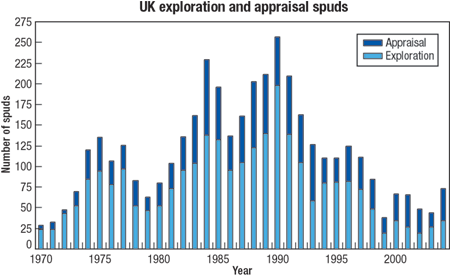 |
Fig. 1. This chart of E&A wells drilled by year on the UKCS shows that the total hit a six-year high during 2004.
|
|
In Fig. 2, number of wells drilled on the UKCS, by company, new entrant Oilexco clearly leads the field. Several of these spuds were sidetracks on Brenda field.
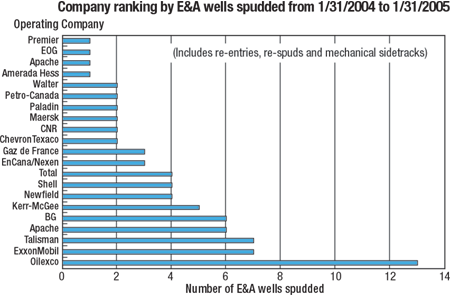 |
Fig. 2. Exploration and appraisal wells drilled on the UKCS,
by individual companies.
|
|
Fig. 3 is an offshore exploration success ratio graph, dating back to 1970. It shows the percentage of successful exploration wells drilled each year, with a five-year moving average shown by the red line. A successful well is one classified by the operator as an oil, gas or condensate well (or any combination thereof). The graph includes all re-entries and geological sidetracks, but it does not include re-spuds or mechanical sidetracks. Although variable from year to year, the success rate has averaged about 35%. Recently the rate has tended to be lower than this average.
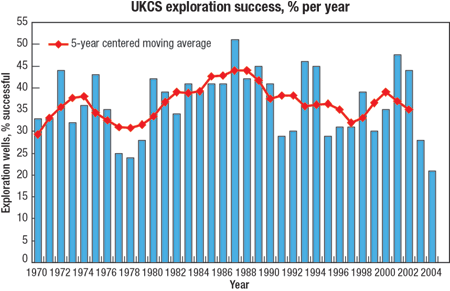 |
Fig. 3. Exploration success by year on the UKCS.
|
|
Development/ production. Between 2003 and 2005, output began from five oil/ condensate fields – Ardmore, Braemar, Broom, Clapham and Howe. Birch field re-started production after being shut-in for two years. BP’s Clair field achieved first oil in February 2005, and it should plateau at 60,000 bopd and 15 MMcfgd. Venture’s Gadwall field (part of the greater Kittiwake area) went onstream in April 2005, with technically recoverable reserves of about 6.4 million barrels of oil. Peak output will be around 5,300 bopd.
Petro-Canada’s Pict field is expected to average about 10,000 bopd for the next three years, following production start-up in June 2005. Two more oil/ condensate fields, Franklin West and Glenelg, should come onstream during second-half 2005. UKCS liquids production for 2005 is expected to average around 2.11 million bopd. It is forecast that output will remain fairly constant in 2006, after which a steady decline is anticipated.
Between 2003 and 2005, seven gas fields went onstream, including Carrack, Helvellyn, Rivers, Rose, Scoter, Valkyrie and Goldeneye (gas/ condensate). ExxonMobil’s Arthur field began production last January, with recoverable reserves totaling 130 Bcf. Arthur should peak in 2006 at 79 MMcfgd. Last April, Venture-owned Annabel field went onstream. It should average around 48 MMcfgd throughout 2005, and peak at about 79 MMcfgd in 2006.
Tullow’s Horne and Wren fields began producing in second-quarter 2005 and have already reached a peak output rate of around 90 MMcfgd. Four gas fields should go onstream during second-half 2005, including Atlas/ Hyperion, Glenelg, Rhum and the Tors Area. UKCS gas production, for 2005, is expected to average 9.8 Bcfgd. The increase in UKCS gas output experienced since the early 1990s hit a plateau at about 11 Bcfd in 2001. Production remained fairly constant to 2003, but there has been a steady decline since then.
Although high oil prices have reduced the number of producing asset deals, significant interest has been drawn to the North Sea through several government incentives. Considerable investment may be made by independents building portfolios, either through licensing round entry or as a result of schemes and initiatives introduced by such bodies as PILOT.
The UKCS has over 300 undeveloped discoveries. Officials have a renewed commitment to unlocking these fields’ potential through such initiatives as the satellite accelerator. Their commitment to maintaining output at 3 million boed, and reaching an investment target of £3 billion/ annum, means that UKCS production may not decline significantly in the near future. Forecast output in Fig. 4 does not include discoveries.
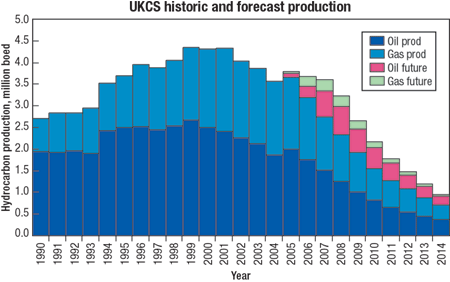 |
Fig. 4. Historic and forecast production on the UKCS over a 14-year period.
|
|
NORWAY
Back in May 2003, the Ministry of Petroleum and Energy changed the licensing system, in another attempt to stimulate more efficient exploration in mature parts of the Norwegian Continental Shelf (NCS). Awards in pre-defined areas were introduced. This new licensing system replaced the North Sea awards and has aimed to provide applicants with a better picture of what they will be offered through establishment of a fixed, pre-defined exploration area.
Last December, the ministry offered 28 production licenses to 21 companies in the North Sea, Norwegian Sea and Barents Sea, covering 55 blocks and partial blocks. In January, the ministry said that 192 blocks and/or partial blocks would be included in the 2005 Pre-defined Areas. Deadline for submission of applications is Sept. 30, 2005. The awards should be made in December.
Running concurrently with the awards in Pre-defined Areas, the ministry last October invited oil companies to nominate blocks for inclusion in the 19th Licensing Round on the NCS. Blocks open for nomination included areas already open to petroleum activities in the Norwegian and Barents Seas, on which 19 companies nominated 61 blocks last March. In June, Norwegian Minister of Petroleum and Energy Thorhild Widvey announced the 64 blocks that would be included in the 19th Licensing Round. This round includes frontier areas within the Barents Sea. The closing date for applications is Nov. 15, 2005, with awards expected to be made in first-quarter 2006.
E&A drilling. Nineteen E&A wells were started in 2004 (including two re-entries), the lowest number of Norwegian spuds since 1972. Once again, the Norwegian success rate declined, Fig. 5. Three new discoveries were made – Linerle, Topas and West Cable. The Linerle accumulation was found by Statoil’s 6608/11-4 well, which targeted the Båt Group and encountered a significant oil column.
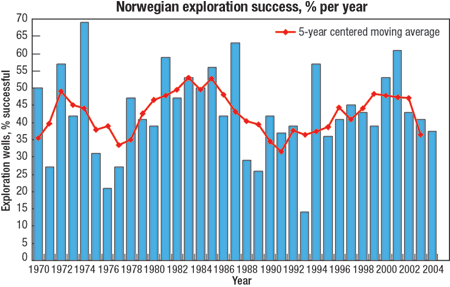 |
Fig. 5. Norway’s exploration success rate declined for a third straight year.
|
|
Topas is a satellite accumulation in the Gullfaks area that straddles Blocks 34/7 and 34/10. Oil was proved in Middle Jurassic and Upper Triassic sandstones in both blocks by deviated Gullfaks platform well 34/10-48 S. ExxonMobil drilled well 16/1-7 into the West Cable structure, which may straddle partial Blocks 16/1a (PL001B) and 16/1c (PL242). It encountered oil in the Middle Jurassic, Hugin and Sleipner formations.
During 2004, successful appraisal wells were drilled in the Alve (Shell), Hamsun (Marathon) and Ringhorne (ExxonMobil) fields. During the first four months of 2005, six wells (four exploration and two appraisal) were spudded (including two re-entries). In the first four months, no new Norwegian finds were made, although hydrocarbons were proved in the Sklinna (Eni) and Topas (Statoil) structures.
Development/ production. Unlike the UK, most of Norway’s production comes from a smaller number of large fields, although development and production of smaller satellite fields close to existing, planned infrastructure is ongoing. Additional satellite fields in the Norne, Gullfaks, Oseberg, Sleipner and Statfjord areas are being developed or are under consideration.
New developments should maintain Norwegian liquids output at about 3 million bpd in 2005 and 2006, Fig. 6. Liquids production will decline from 2007 onward. This decline will be offset by the introduction of unallocated gas/ condensate fields. Gas output should average around 210 MMcmd in 2005 and will continue to increase. By 2009, we estimate that gas production will be around 360 MMcmd. The decline in gas output from fields already in production will be more than offset by contributions from new fields, mainly the giant, 14-Tcf Ormen Lange field, plus the Snøhvit and Skarv areas.
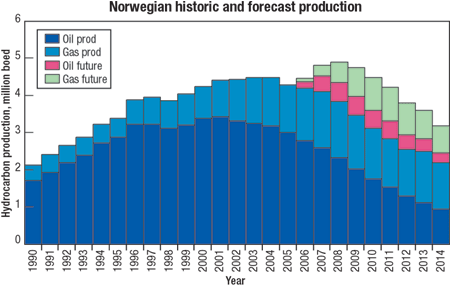 |
Fig. 6. Historic and forecast production in Norway over a 14-year period.
|
|
NETHERLANDS
Activity offshore the Netherlands is subject to the Continental Shelf Mining Act of 1965. Blocks are initially awarded as exploration licenses. If commercial discoveries are made, then firms can apply for production licenses. In each round, all non-licensed areas that are not in restricted zones are made available.
The result of a 1995 decree is that the Netherlands is now running an open-door licensing arrangement under the Ninth Licensing Round. During 2004, Total was awarded a spontaneous production license on K/2c, due to the likely northern extension of the K/5b field into that block. Gaz de France was awarded two production licenses on G/14 and G/17a, enabling development of those fields. Petro-Canada was awarded a production license on P/11b, following an application made in February 2004 for the exploration license. The application concerns De Ruyter field, which extends into adjacent Block P/10 (on which Petro-Canada has also submitted a production license application).
E&A drilling. Eight exploration wells and two appraisals were drilled during 2004 (including two mechanical sidetracks). Wintershall drilled well L/8-16 to the south of the L8-A and L8-H gas accumulations. It tested gas from a Rotliegendes reservoir. L/8-16 was drilled as part of a farm-in deal, for which EWE gained a 20% interest in L/8a. Gaz de France also found gas in exploration well G/17-5. In the first four months of 2005, three new wells were drilled, but no new finds were made.
Development/ production. Some offshore gas was produced between 1970 and 1974, but it was not until 1975 that output became significant. At that time, Placid’s L10 gas field went onstream at 2.6 MMcmd (93 MMcfd). Production has grown steadily since then, peaking in 2004 at about 79 MMcmd, Fig. 7. Today, offshore sales gas production is running at about 75 MMcmd.
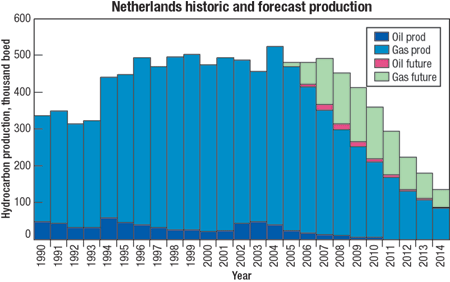 |
Fig. 7. Historic and forecast offshore production in the Netherlands over a 14-year period.
|
|
The government and Gasunie are eager to promote offshore development, given that their long-term strategic objective is to conserve the reserves of the massive, onshore, Groningen gas field, which continues to decline. As of Jan. 1, 2005, remaining commercial gas reserves in all offshore fields were about 267 Bcm.
Significant near-term developments include the F16-E field, due to go onstream in second-half 2005, with technically recoverable reserves totaling 13 Bcm of gas. The De Ruyter P10/P11b field operated by Petro-Canada should also go onstream in 2006, adding 28 million bbl of oil reserves to the Dutch sector. Development of Gaz De France’s G14 and G16a fields is underway, with start-up expected in 2006 via G17cd. Combined, technically recoverable reserves are about 10 Bcm.
Phased development of five gas fields in A and B quadrants should yield first gas from the A12-FA field in 2007, followed by development of B13 and A18 as part of the first phase. The second phase will develop B10a, A12b and B16 fields. With questions being raised over marginal fields’ commerciality in the Dutch sector for the majors, various factors (abolishment of depreciation and high oil prices) are at work, dictating whether or not many potentially commercial, marginal assets will get the go-ahead.
DENMARK
On May 20, 1997, the Open Door procedure took effect for all areas offered for licensing to the east of the Central Graben – irrespective of whether they lie onshore or offshore. The dividing line was at 6° 15’ east. Through the Open Door procedure, oil companies can apply for licenses at any time during the annual period from Jan. 2 until Sept. 30.
Last November, Open Door license 1/04 was awarded to Clam Petroleum Danske B.V., with partners Kerr-McGee, BP and DONG. The license covers an area at the Norwegian/ Danish border in the eastern North Sea. So far in 2005, the Danish Energy Authority (DEA) has received an application for one license in the Open Door Area. The applicants, Willumsen Exploration Consultants ApS (WeXco ApS) and Odin Energi A/S, have applied for a number of onshore blocks in southern Jutland.
In May 2005, DEA listed the blocks on offer in the Sixth Licensing Round, along with new terms. Acreage on offer lies mainly in the Central Graben, but it also includes blocks farther to the east. As in other rounds, the Danish state will hold a 20% share in all new licenses. Generally, licenses will be for six-year exploration phases, with rights to 30-year extensions for fields that produce.
While assessing the tenders, DEA will attach importance to the amount of wells that bidding companies plan to drill. Deadline for submitting tenders is Nov. 1, 2005.
E&A drilling. Most Danish wells have been drilled in the Central Graben, in the west of the sector, but Statoil’s first discovery outside this area brought a new dimension to Danish exploration. That find, Siri, began producing oil in March 1998. In recent years, several new discoveries have been made in the area, including Cecilie, Connie, Francisca, Nini and Sofie. Seven E&A wells were drilled offshore Denmark 2004, with no success. In 2005, so far, one exploration well has been drilled unsuccessfully on the Sissel prospect, with one appraisal well on Nini.
Development/ production. Danish oil production totaled 144 million bbl last year, equating to about 395,000 bpd. Seventeen fields contributed to Danish oil output. However, the majority (86%) of produced oil came from just six fields – Dan, Gorm, Halfdan, Siri, Skjold and South Arne. Danish oil production in 2005 should reach 137 million bbl, or about 375,000 bpd.
Danish oil output peaked in 2002, due mainly to an increased production from Halfdan. Annual oil output is expected to remain fairly constant until 2006, after which a steady decline is anticipated. Danish gas production in 2004 amounted to 274.4 Bcf, or 751.7 MMcfd. Gas production in 2005 is expected to reach 325 Bcf, equal to an average 891 MMcfd.
Four potentially commercial fields on the Danish Continental Shelf were expected to begin producing during 2005. These included Adda, Alma, Elly and Igor. In December 2001, the Danish Energy Agency approved postponement of output from these fields until Jan. 1, 2005. In July 2002, the DEA again approved start-up postponement for Adda, Alma, Amalie and Elly until January 2009.
GREENLAND
Drilling in Greenland began in 1976, when Total drilled a dry hole off the western coast. A year later, four further wells were drilled in the same area, and all were unsuccessful. Drilling then ceased until the mid-1990s, when GrønArctic Energy drilled a series of five wells on the Nuussuaq onshore area. All of them found traces of hydrocarbons.
During 2000, Statoil drilled Qulleq 1 in the Fylla license that was awarded in 1996. A Cretaceous sandstone was encountered, but it did not contain hydrocarbons. In 2001, Statoil relinquished the Fylla license in which Qulleq 1 lies. At present, EnCana operates the only two licenses offshore western Greenland – the Atammik license awarded in 2002 and the Lady Franklin license awarded in 2004.
FAEROE ISLANDS
Following the First Faeroese Licensing Round’s success in 2000, the Faeroe Islands Ministry of Petroleum invited companies to nominate blocks that they wished to see included in the Second Licensing Round. All nominations were submitted to the Faeroese Geological Survey in December 2003.
The Second Licensing Round opened in August 2004, with applications accepted by the Petroleum Administration until mid-November 2004. On closure of the awards, the Petroleum Administration said that it had received nine applications from eight companies, arranged into five groups. Last January, Minister of Trade and Industry Bjarni Djurholm awarded seven licenses to eight oil companies, organized into five groups or as individual companies. The firms include Atlantic Petroleum, Chevron, DONG, Faeroe Petroleum, Geysir Petroleum, OMV, Shell and Statoil.
IRELAND
In 2003, Ireland’s Petroleum Affairs Division announced revised terms for Licensing Options awarded for offshore exploration. The measures put in place by Minister of State John Brown at the Department of Communications, Marine and Natural Resources, were effective from Oct. 1, 2003. The changes were made to rejuvenate exploration in the Celtic Sea and possibly other areas in the future.
The revised terms’ main points are:
- Both the work program and the applicant’s commercial considerations will determine a licensing option’s duration. It will be for a period of one, two or three years, but a shorter period may be agreed for a particular program.
- The minister may extend the licensing period by no more than 12 months beyond the original expiration date on the basis of both a further, agreed work program and/or specific commercial considerations.
- Rental fees are to be reduced with immediate effect to be the same as for Phase 1 of Frontier Exploration Licenses – EUR 27/sq km. This rate will also apply to any extension beyond original terms.
In May 2004, Minister Brown announced a Rockall basin Licensing Round that closed on May 31, 2005. The second phase of the Frontier Licensing Round was announced last January. Blocks on offer lie in the Slyne, Erris and Donegal basins. Second phase applications must be filed by March 15, 2006.
E&A drilling. In 2004, one new well was spudded. ADTI drilled 49/26-1 on behalf of Providence and encountered hydrocarbon shows beneath the main Wealden reservoir interval.
Development/ production. Seven Heads gas field, 32.5 km west/ southwest of Marathon’s Kinsale Head field, was discovered by Esso in 1973. Current operator, Ramco Energy, and its partners were granted a licensing option for the field in October 1999. Development approval was granted in March 2003, with first output in December 2003 at 60 MMcfgd.
Seven Heads has been developed via six subsea wells tied back to the Kinsale Head platform. Initial re-estimate of recoverable reserves was 400 Bcf, with some upside potential possible. In 2004, the wells’ production performance resulted in a downgrade of Seven Heads’ recoverable reserves.
A comprehensive technical review was carried out, which found that the reservoir is severely faulted and further compartmentalized than initially predicted. As a result, the existing wells are connected to a much smaller volume of gas-bearing rock. Recoverable reserves are now put at 28 Bcf, and the aim is to acquire 3D seismic, re-enter the wells and add perforations to increase reserves. Ramco also has its interest in Seven Heads up for sale.
Following much discussion and debate, the Corrib project was finally given the go-ahead in late 2004, with 42 conditions to satisfy. First gas has been postponed until mid-2007 with transportation via a 20-in., 84-km subsea pipeline. It will make a landfall at Broadhaven Bay in County Mayo and continue 9 km onshore to the terminal. Technically recoverable reserves are about 24 Bcm of gas. 
| |
UKCS spending is up, but future composition of players is uncertain |
|
| |
North Sea Investment Recovers
Spending is on the way up. Norway expects a record-high £7.5 billion (£1 = $1.75) this year, up from £6 billion in 2004. In the UK, spending will creep up to just beyond £9 billion this year from £8.9 billion in 2004. Longer term, operating and capital expenditures should total about £35 billion in UK waters from now to 2010, reflecting greater confidence in a mature province.
E&P Conundrum
In just a few short months, the North Sea has become a much tougher place for new entrants to gain a footing. During first-half 2004, with oil prices in the mid-$30s, an active market was developing, but the $50 barrel has changed that. “This year, we’re in a completely different price landscape,” said 3i’s oil and gas director, Graeme Sword. “It’s a difficult landscape for deals to take place, for new players to become established. Overall, private equity activity in E&P is down. In our 2004 white paper, we talked about a big market happening, with Deloitte forecasting a £4 billion market over the next four or five years. But we’ve not made much of a dent into that at all.”
Assets market dries up. “Smaller companies are really struggling to acquire assets,” said Sword. “There are a lot of them chasing producing fields, but at current oil prices, there’s just no reason for the majors to sell, when they can generate such strong cash flows. Their accent is on development and tidying up portfolios around the edges.”
Investors’ Perspective
Historically, private equity was not attracted to North Sea E&P for cyclical reasons – it was oil price-driven, it was not a private company environment, and few assets were available. Many analysts had expected this to change during the mid-to-late 1990s, during a transitional market. Mega-mergers had created expanded portfolios, offering chances for rationalization and asset sales. Despite such rhetoric, the market never developed. Post-merger sales did not happen, output targets led to asset retention, and M&A activity did not grow at the expected rate.
Asset availability. One reason for why the market has not developed is that high commodity prices resulted in record cash flows and strong balance sheets, yet there is continual pressure to deliver returns. The result of a lot of cash and few opportunities is a very competitive M&A market, making it very hard for private equity companies to acquire assets. However, the UKCS is still a large, liquid market, second only to North America.
Limiting factors for independent growth. Although competition for assets is a major issue, several other factors are inhibiting sector growth. According to 3i, there are too many small companies, and some consolidation is needed. As an illustration, the UKCS has failed to replace Lasmo and Enterprise, and create a UK independent with a market capitalization of £1 billion-plus.
|
|
|
|









